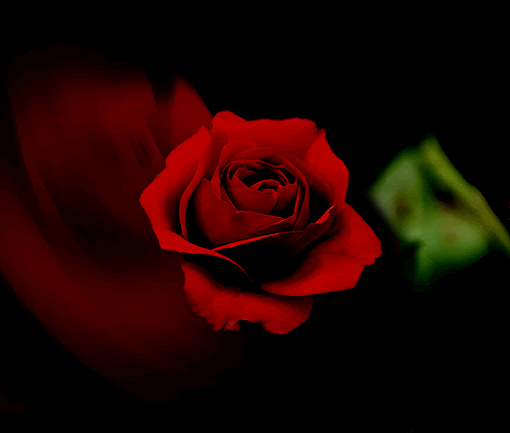«My Sweet Rose»
🌷 Soul of the Rose - 1908 🌷
John William Waterhouse
The Pre-Raphaelites - Romanticism

The painting shows the mortal Psyche admiring the Eros’s magical garden, the Greek god of Life.

The painting shows the mortal Psyche admiring the Eros’s magical garden, the Greek god of Life.
"The Soul of The Rose" also known as "My Sweet Rose" - one of the most successful works Waterhouse. It completely embodied the ideal which throughout his life he glorified the artist. It's a romantic sophistication, symbolism, detachment, sensuality and feminine at the same time the restraint of emotions.

The most famous works of Waterhouse are illustrations to a literary or historical events. "The soul of the Rose" is an exception, but this work is not a portrait or a fantasy author. This is a portrait-impression of the poem by Tennyson, "Maud", the most famous passage: "Come into the garden, Maud".
The poem describes the tragic love of the young man to Maud, daughter of rich. They are not meant to be together, death and mental illness are waiting for the main characters, but Waterhouse grabs the viewer only one row and the light image:
«And the Glow of the Rose went into my Chest, Flooding my Soul»
which in English sounds like:
«And the Soul of the Rose went into my Blood»
In this line and found the famous phrase "soul of the rose"that is the "soul of the rose", taken as the title of the painting.

Color and Symbolism
« Soul of the Rose»
Like most of Waterhouse's paintings, in the center of the composition is the female figure. The background plays a secondary role, do not carry any meaning, but it creates a sense of isolation, captivity. A stone wall, to which clung Mod, inhaling the scent of blooming roses, is a trap for women, it is an obstacle to freedom and love. She slightly turned away from the viewer, making it clear that he fully immersed in their dreams and memories.

The product is soft, free strokes. Details the important details of the picture - head of a woman, her hands and the flowers themselves, which is a conceptual and compositional center of the work. Everything else loses its importance and the physical perceptibility due to the air impressionistic writing style.
"The soul of the Rose" is one of the works in the series, written in 1908 and dedicated to the favorite subject of the English romanticists - girls and flowers: "Pluck the roses as soon as possible"1908, "Pluck the roses as soon as possible"1909 and "Ophelia. Collected rosebuds". Waterhouse reveals in this seemingly banal plot is not only feminine beauty, sensuality, but also the transience of time, the desire to have time to enjoy wonderful. The painting was purchased into a private collection at Christie's in 1981.

John William Waterhouse
(1849–1917)


John William Waterhouse RA (6 April 1849 – 10 February 1917) was an English painter known for working first in the Academic style and for then embracing the Pre-Raphaelite Brotherhood's style and subject matter. His artworks were known for their depictions of women from both ancient Greek mythology and Arthurian legend.
Born in Rome to English parents who were both painters, Waterhouse later moved to London, where he enrolled in the Royal Academy of Art. He soon began exhibiting at their annual summer exhibitions, focusing on the creation of large canvas works depicting scenes from the daily life and mythology of ancient Greece. Many of his paintings are based on authors such as Homer, Ovid, Shakespeare, Tennyson, or Keats.
Waterhouse's work is currently displayed at several major British art galleries, and the Royal Academy of Art organised a major retrospective of his work in 2009.
His early life in Italy has been cited as one of the reasons many of his later paintings were set in ancient Rome or based upon scenes taken from Roman mythology.
Waterhouse's early works were not Pre-Raphaelite in nature, but were of classical themes in the spirit of Alma-Tadema and Frederic Leighton. These early works were exhibited at the Dudley Gallery, and the Society of British Artists, and in 1874 his painting Sleep and his Half-brother Death was exhibited at the Royal Academy summer exhibition.
The painting was a success and Waterhouse would exhibit at the annual
exhibition every year until 1916, with the exception of 1890 and 1915.
He then went from strength to strength in the London art scene, his 1876
piece After the Dance being given the prime position in that
year's summer exhibition. Perhaps due to his success, his paintings
typically became larger and larger in size.
In 1883 he married Esther Kenworthy, the daughter of an art schoolmaster from Ealing
who had exhibited her own flower-paintings at the Royal Academy and
elsewhere. In 1895 Waterhouse was elected to the status of full
Academician. He taught at the St. John's Wood Art School, joined the St John's Wood Arts Club, and served on the Royal Academy Council.
One of Waterhouse's best known subjects is The Lady of Shalott, a study of Elaine of Astolat as depicted in the 1832 poem by Alfred, Lord Tennyson, who dies of a mysterious curse after looking directly at the beautiful Lancelot.
He actually painted three different versions of this character, in
1888, 1894, and 1916. Another of Waterhouse's favorite subjects was Ophelia;
the most familiar of his paintings of Ophelia depicts her just before
her death, putting flowers in her hair as she sits on a tree branch
leaning over a lake. Like The Lady of Shalott and other
Waterhouse paintings, it deals with a woman dying in or near water. He
may also have been inspired by paintings of Ophelia by Dante Gabriel Rossetti and John Everett Millais. He submitted his 1888 Ophelia painting in order to receive his diploma from the Royal Academy. (He had originally wanted to submit a painting titled A Mermaid,
but it was not completed in time.) After this, the painting was lost
until the 20th century. It is now displayed in the collection of Lord Lloyd-Webber. Waterhouse would paint Ophelia again in 1894 and 1909 or 1910, and he planned another painting in the series, called Ophelia in the Churchyard.
Waterhouse could not finish the series of Ophelia paintings because he was gravely ill with cancer by 1915. He died two years later, and his grave can be found at Kensal Green Cemetery in London.











No comments:
Post a Comment